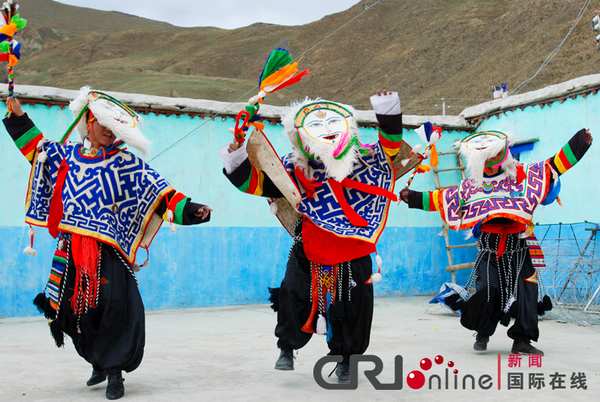
White-mask Tibetan Opera, a sect of Tibetan Opera developed in Lhoka Prefecture of southwest China's Tibet Autonomous Region. [Photo/CRI]
In a courtyard, a few villagers with Tibet's first Tibetan Opera troupe were absorbed in having a rehearsal; the troupe, which once has broken up due to fund shortage, has been reviving after Tibetan Opera was listed as China's national intangible cultural heritage in 2006.
Tibetan Opera, originated over 600 years ago, is reputed as the "living fossil" of Tibetan culture. The white-mask Tibetan Opera is among the various opera sects generated due to varied natural conditions, lifestyles, cultural traditions and languages in different places of Tibet.
Though set up earliest in Tibet, the Tibetan Opera troupe in Bendo Village of Lhoka Prefecture in southern Tibet had to break up as a result of financial difficulty in the 1980s.
The troupe has been reviving its vitality quickly after receiving special funds from the central government of China since 2006, said Badro, an inheritor of white-mask Tibetan Opera in the village.
"We were capable to build the stage for rehearsal and buy the stage costumes and properties only with the funds and support from both the central government and regional government," said Badro. "We gained relevant subsidies from opera rehearsal as well."
With well-equipped facilities, the actors in the troupe now need only an easy rehearsal the day before performing.
Through well development and inheritance, the troupe now has 28 actors, more than twice as much as the number in the early period of reestablishment. Most of the actors were around 20 years old.
These actors have about five or six performances per year and attend almost all the major activities of Tibet, according to Bardro.
As an icon of the traditional Tibetan culture, the white-mask Tibetan Opera is also included in the cultural conservation and inheritance programs with 6 million yuan special fund allocated by Lhoka Prefecture so far, according to Yufei, an officer in the local administrative office.
Tibetan culture has gained well protection and inheritance since the peaceful liberation of Tibet in 1951.
In recent years, Lhoka Prefecture has been making great effort in protecting and rescuing its various cultural heritages through talent construction, investment, holding activities, making international exchanges and creating characteristic and modern ethnic cultural goods.
Lhoka prefectural and county governments will put 3% of their financial capital as special funds for development of cultural industry to further boost the ethnic cultural industry, said Yufei.
"All the efforts we made and achievement gained in cultural protection, development and inheritance are the powerful truth to attack the fallacy of 'cultural genocide' by the Dalai Clique." she added.
